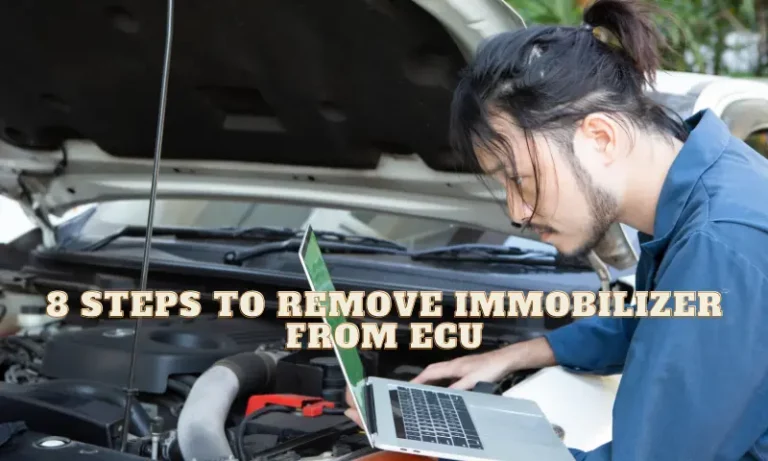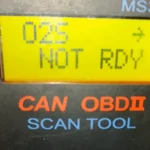The engine Immobilizer is a work of technology, even in the automotive world. Many automakers integrate this security feature into cars to help protect your car from theft.
Yet, some circumstances might need you to remove the immobilizer, either entirely or before installing another one. This article will pinpoint the steps to remove your immobilizer from the ECU. Let’s get started.
What You Should Know About an Immobilizer
An immobilizer system is an in-built security system that deters those who do not have the right key from igniting your car. As a result, it protects your car from theft. This authorized and coded key usually contains a transponder chip.
This transponder chip stores and transmits authentic passcode. When you insert your key fob in your vehicle, the chip passes the code to the vehicle’s ECU. Then the immobilizer authenticates the code in the ECU with the code from the chip.
If it does meet the code in the system, your vehicle will start. But if the code isn’t the same, the ECU will not enable the fuel system or activate the ignition circuit.
Most immobilizers have an alarm to alert you if someone tries to turn on your vehicle against your consent. The immobilizer system differs from the alarm system. While an alarm only alerts the owner by producing a sound, it doesn’t practically stop a thief from stealing the vehicle.
In comparison, the immobilizer prevents the vehicle’s ignition and hinders mobilization. It is possible to remove the immobilizer function from your vehicle. That will enable you to turn on your engine without a passcode key.
Hotwire, hammer or screwdriver, and the red coil wire, are all traditional methods of starting a vehicle. The immobilizer system contradicts these dangerous techniques.
Tips on How To Remove Immobilizer from ECU
Removing an immobilizer may become necessary under some conditions. If the immobilizer goes bad, you may need to replace it. Another reason may be that you want to upgrade the system to update the car insurance or add new security features.
Again, if you remove or replace your car’s battery, you may lose critical information. Also, if an electrical surge damages your ECU, you may need to replace your car’s ECU.
To do so requires knowledge of how to remove the Immobilizer, particularly from the ECU. After you replace your ECU, it must undergo programming to enable the immobilizer system to function efficiently.
Another case is when you lose your original key and decide to get a new one. If the new key isn’t rightly programmed, you will find it challenging to start your engine.
How to Remove Immobilizer from ECU: Simple Steps
Follow these steps to remove an immobilizer from an ECU successfully. It doesn’t matter if it’s an OEM or aftermarket immobilizer. The procedure is similar. The vehicle I’ll be working on is Mazda 93MX-5.
Step 1: Lower the steering column: At the top of your car’s steering system is a steering column located. Lower the column to be able to access all parts and easily work.
Step 2: Remove the steering column cap: Removing the cap will enable to access the led wire that leads to the immobilizer unit.
Step 3: Trace the cable: Trace the wire that leads to the unit and here you need to be sure that you’re tracing the right cable. The cable is often tied up
Step 4: Disconnect and snip the wire out: You need to remove the wire from its fuse. Sometimes, it may have stuck and that will require you to get a side cutter to cut it off.
Once you disconnect and pull out the cable, you’ll see the ME6 Immobilizer: You may be a bit confused because the loom can seem large.
Step 5: Cut the insulator: With a Stanley blade, you should cut the insulator around the wire.
Step 6: Unplug the Ignition switch: There’s a permanent 12-volt feed that sends an electrical voltage to the ignition. So, when you turn the ignition key to an ON position, the wire receives voltage. The reason for taking this step is to get more room to work on the immobilizer.
Step 7: Hold the trigger wire: Now, you’re face-to-face with the trigger wire which prevents current from getting into the immobilizer until you register the dongle in the receiver. The immobilizer is wired to this part of the ECU.
Step 8: Crack up the two piles of the earth: Crack off the two piles of earth to 12 mils and you can access the big fuse box. Disconnect the battery, and short the two wires that lead to the ignition connector.
There you have the immobilizer removed from the ECU. It’s that simple.
FAQs
How can I tell if my vehicle has an immobilizer?
First, you can check your dashboard for the Immobilizer or key icon. If you find the icon, it means your car has an engine immobilizer installed. Another way is to turn to your car’s handwork. There, you can obtain information about whether your car has an engine immobilizer.
Will my car stop working after removing the immobilizer?
No, your car will function regardless. If you experience starting problems due to one or more issues from the immobilizer, you can bring your car back to life by removing the immobilizer.
Final Thoughts
An immobilizer is your car’s security system that sounds an alarm if anyone tries to ignite your vehicle with the wrong code. It ascertains if the vehicle operator is the actual owner of the vehicle. In effect, it lessens the chances of theft. Even so, it isn’t guaranteed that your vehicle isn’t susceptible to theft.
Still, it can also be problematic and affect your car’s performance. The problem includes alarm failure, wiring issues, stuck door locks, etc. Remember that completely removing your immobilizer will require a change in the ECU programming. So, a piece of advice is to leave the task to a professional. Removing an immobilizer should not take much time under normal conditions. The cost differs from vehicle to vehicle. Depending on your mechanic, vehicle type, and model, the cost of removing it differs. I hope this helps.



